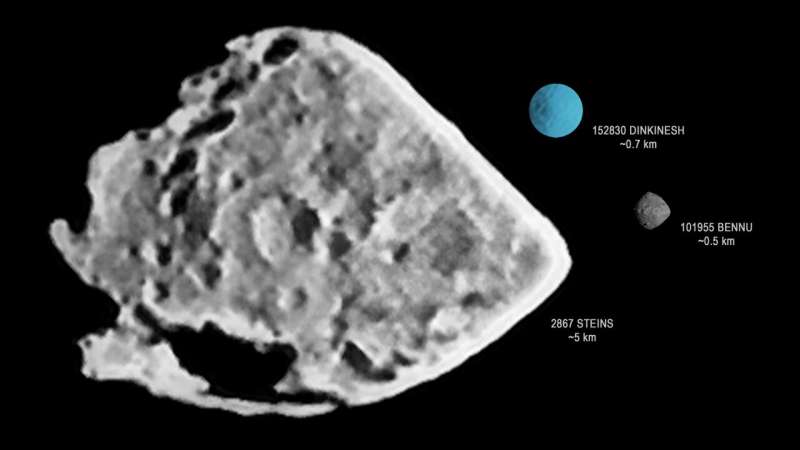This article has been reviewed according to Science X's editorial process and policies. Editors have highlighted the following attributes while ensuring the content's credibility:
fact-checked
trusted source
proofread
NASA's Lucy asteroid target gets a name

The first asteroid to be visited by NASA's Lucy mission now has a name. The International Astronomical Union has approved the name (152830) Dinkinesh for the tiny main belt asteroid that the Lucy spacecraft will encounter on November 1, 2023. "Dinkinesh," or ድንቅነሽ in Amharic, is the Ethiopian name for the human-ancestor fossil, also known as Lucy, which was found in that country and currently curated there. Dinkinesh means "you are marvelous" in Amharic.
In 1999, when the asteroid Dinkinesh was first discovered, it was given the provisional designation 1999 VD57. It earned an official number, (152830), several years later when its orbit was sufficiently well determined. But, like most of the millions of small asteroids in the main asteroid belt, it was left unnamed. However, once the Lucy team identified this asteroid as a target, the team proposed this new name, inspired by Lucy's mission to explore remnants of the early solar system.
"This mission was named for Lucy because just as that fossil revolutionized our understanding of human evolution, we expect this mission to revolutionize our understanding of the origin and evolution of our solar system" said Keith Noll, Lucy project scientist, from NASA's Goddard Space Flight Center in Greenbelt, Maryland. "We are excited to have another opportunity to honor that connection."
The main reason the team has added Dinkinesh to Lucy's already packed tour (10 asteroids, including the newly discovered satellites) is to test the innovative terminal tracking system, which is critical for precise imaging during these high speed encounters. While the asteroid is less than half a mile (less than a km) in diameter, it is an excellent opportunity to test out Lucy's systems prior to the main scientific activities of the mission: learning about the never-before-explored Jupiter Trojan asteroids, which are in many ways fossils of our early solar system.
"This is really a tiny little asteroid," said Hal Levison, Lucy principal investigator, from Southwest Research Institute's (SwRI) Boulder office. "Some of the team affectionately refer to it as 'Dinky.' But, for a small asteroid, we expect it to be a big help for the Lucy mission."
While the main purpose of this encounter is as an engineering test, mission scientists are also excited for what this tiny asteroid might teach us. This will be the smallest main belt asteroid ever explored, and it is much closer in size to near-Earth asteroids that were recently studied by spacecraft than the main belt asteroids previously visited by other missions.
"At closest approach, if all goes smoothly, we expect Dinkinesh to be 100s of pixels across as seen from Lucy's sharpest imager," says Simone Marchi, deputy principal investigator, also from SwRI. "While we won't be able to see all the details of the surface, even the general shape may indicate whether near-Earth asteroids—which originate in the main belt—change significantly once they enter near-Earth space."
Dinkinesh may reveal yet another aspect of the evolutionary history of our solar system.
Provided by NASA's Goddard Space Flight Center




















